ARH 2050 Quiz 1
1/73
There's no tags or description
Looks like no tags are added yet.
Name | Mastery | Learn | Test | Matching | Spaced |
|---|
No study sessions yet.
74 Terms
Spotteed Horses with Human Hands
paleolithic period,
N/A
Dordogne, France.
Fact: This type of horse was actually prevalent at the time, showing that these people were painting what they saw

Willendorf Woman
Paleolithic Period
Austria
Fact: She is shown with a large belly, and breasts to express her fertility and therefore the survival of the clan
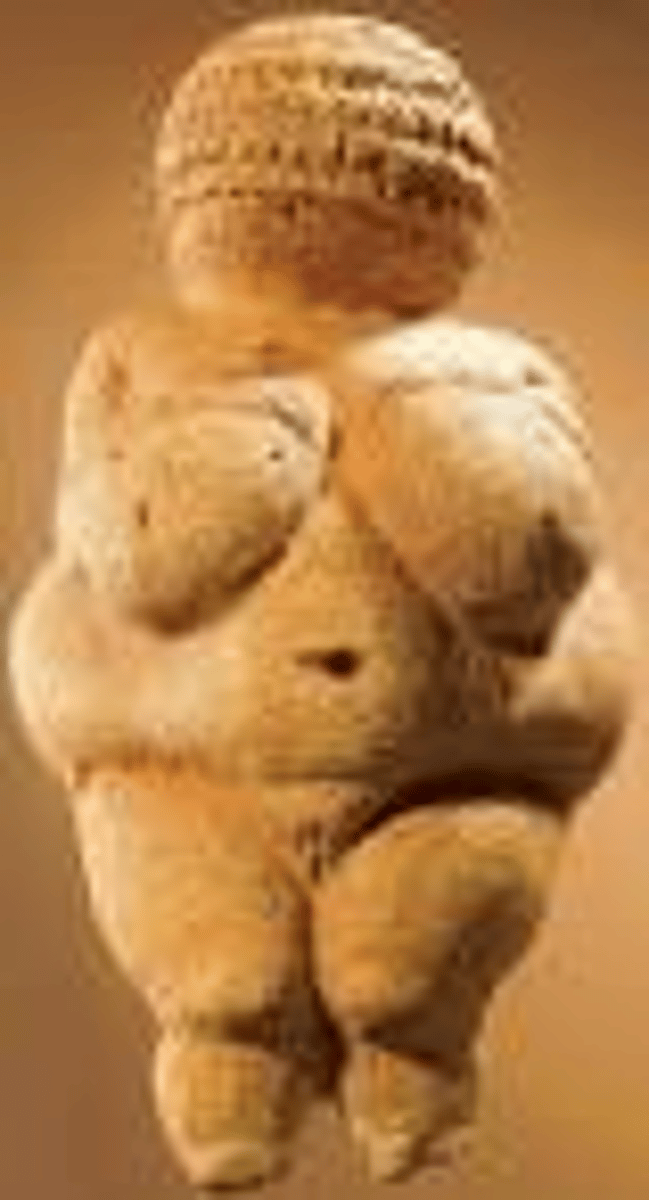
Hall of Bulls
Paleolithic Period
Lascaux cave, dordogne, France
Fact: The bulls were rendered in a profile called a composite pose

Stonehenge
Neolithic Period
Salisbury Plain, Wiltshire, England
Fact: The bluestone used at the site was transported 150 miles from whales to England, leading us to believe these people had their ancestors in Whales.
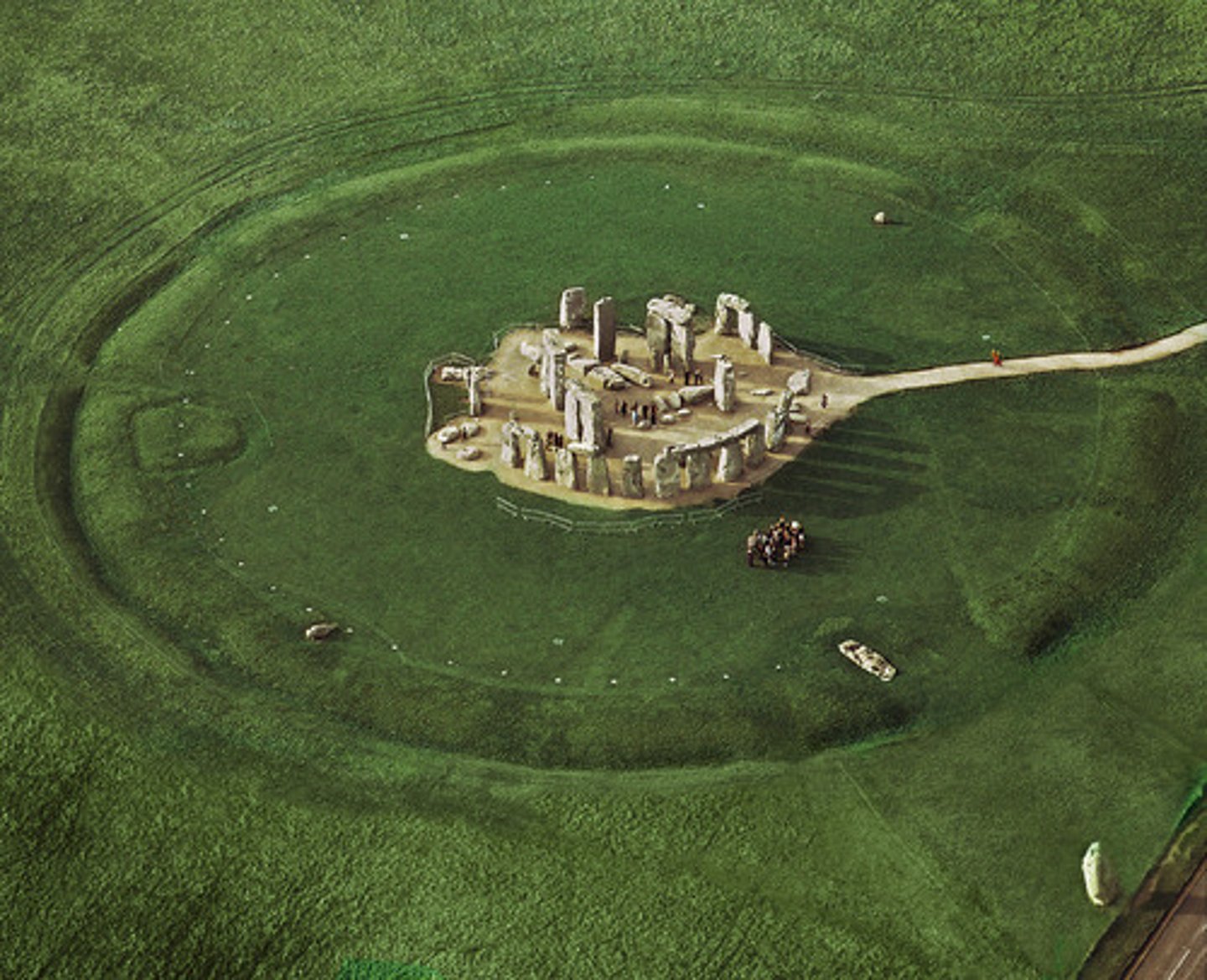
Prehistoric Art
Anything made before written history
Sculpture in the round
Three-dimensional sculpture that is carved free any background or block (Willendorf Woman)
Relief Sculpture
A three dimensional image whose flat background or design is carved away to a certain depth, offsetting the figure
Composite Pose
Combining different viewpoints within a single representation. (Hall of Bulls)
Megalithic
A large stone used in prehistoric Architecture (stone henge)
henge
A circular area enclosed by stones or wood posts set up by Neolithic Peoples. Usually bounded by a ditch and raised embankment
Lintel
A horizontal element of any material carried by two or more vertical supports to form an opening
Mortise-and-tenon
A method of joining two element: A projecting pin (tenon) on one element fits snugly into a hole (mortise) on the other
The Uruk Vase
Ancient Near East Period
Sumerian Culture
Uruk (Iraq)
Fact: Visual Narative is registered into three registers
On the bottom raw food is gathered. In the middle men carry foodstuff, on the top the goddess Inana accepts a gift from two men
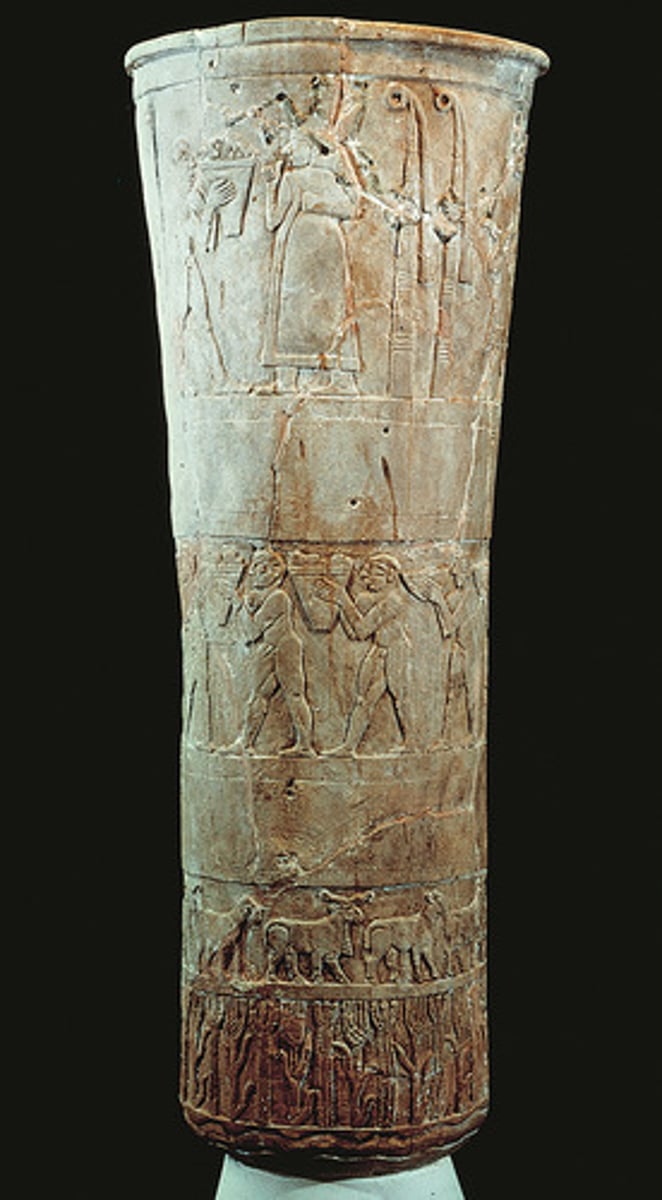
Eshnuma Votive Figures
Ancient Near Eastern Period
Sumerian Culture
Eshnunna (Iraq)
Fact: Each sculpture stood as a stand-in for prayer of the donor, the figures ahd huge wide opened eyes and stood with hands clasped out of respect
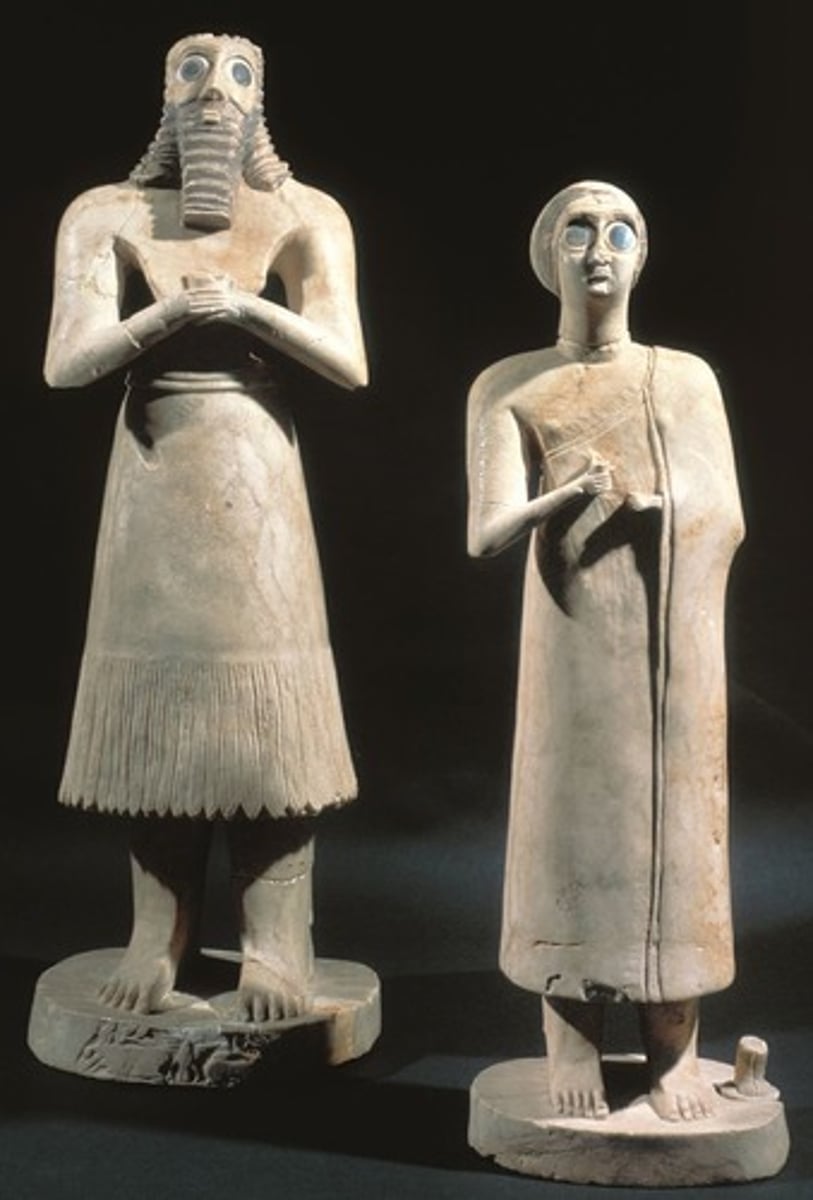
Stele of Naram Sin
Ancient Near Eastern Period
Akkadian
Sippar(Iran)
Fact:Narmon-Sin carved into stone a visual of his grandad (Sargon) above his fallen foes and soldiers. It was the first artwork found to celebrate a specific achievement of an individual ruler.
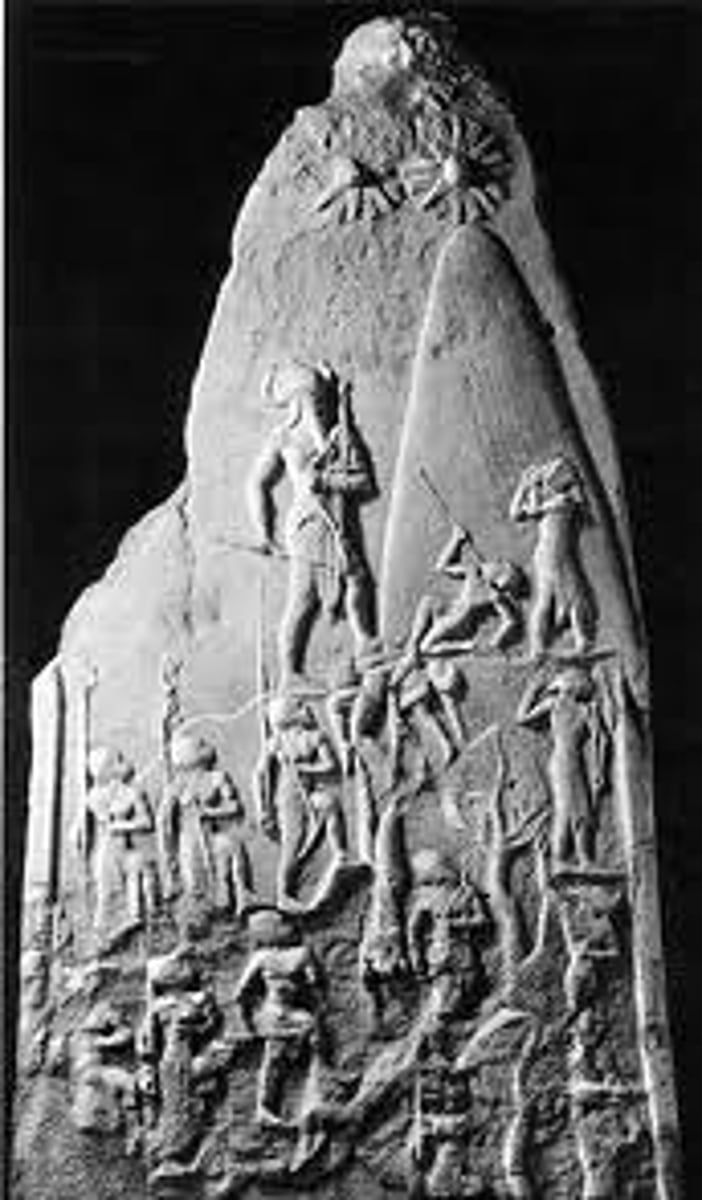
Stele of Hammurabi
Ancient Near East Period
Akkadian Culture
Sippar (Iran)
Fact: Hammurabi is standing in front of Shamash(God of Justice) who is giving him the laws. There are 300 enteries (most deal with property matters)
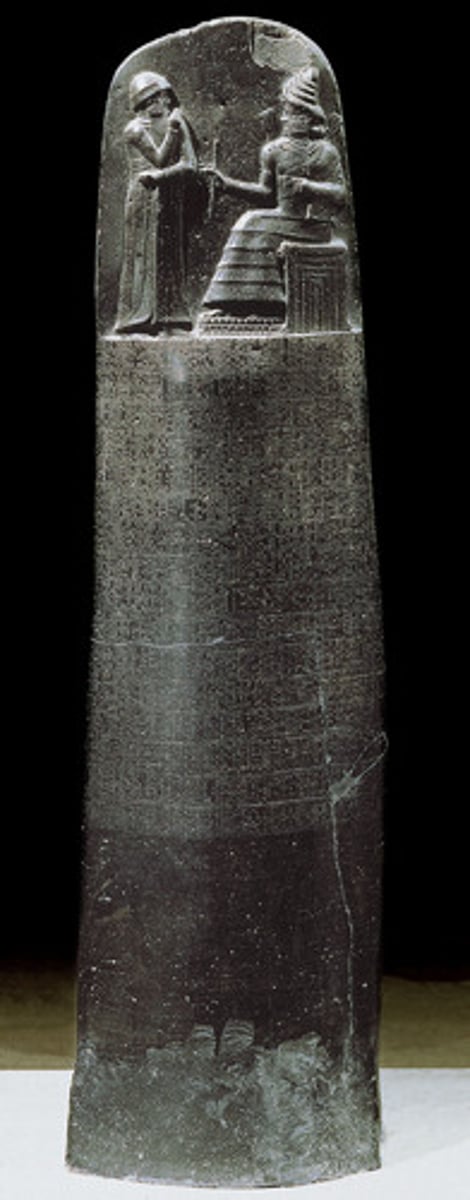
Assurnasirpal II killing lions
Ancient Near East Period
Assyrian Culture
Nimrud(Iraq)
Fact: Assurnasirpal stands on a chariot carried by horses and shoots a lion. This shows a shift in mesopotamian art away from timesless solemnity, and towards a more dramatic and emotional portrayal.
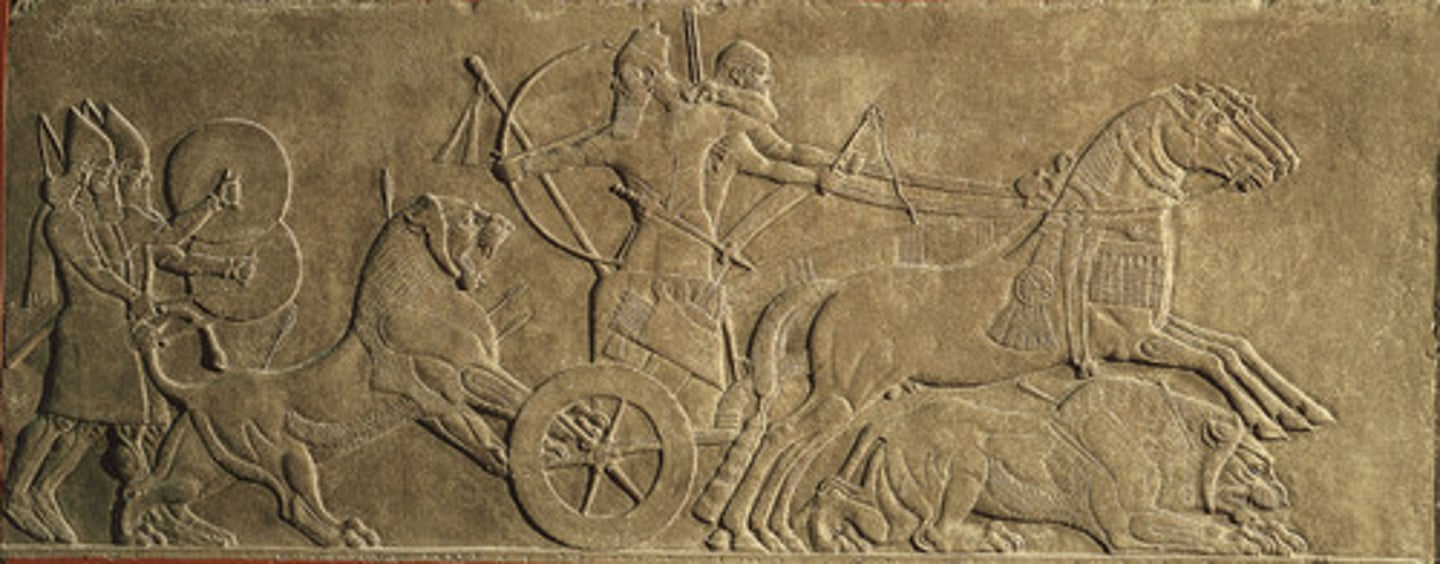
Dur Sharrukin Guardian Figures
Ancient Near Eastern Period
Assyrain Culture
Dur Sharrukin (Iraq)
Fact: Sargon II built it. Accessable only by a wide ramp leading up to an open square where important people gathered. A ziggurat rose declaring the might of the Assyria's king
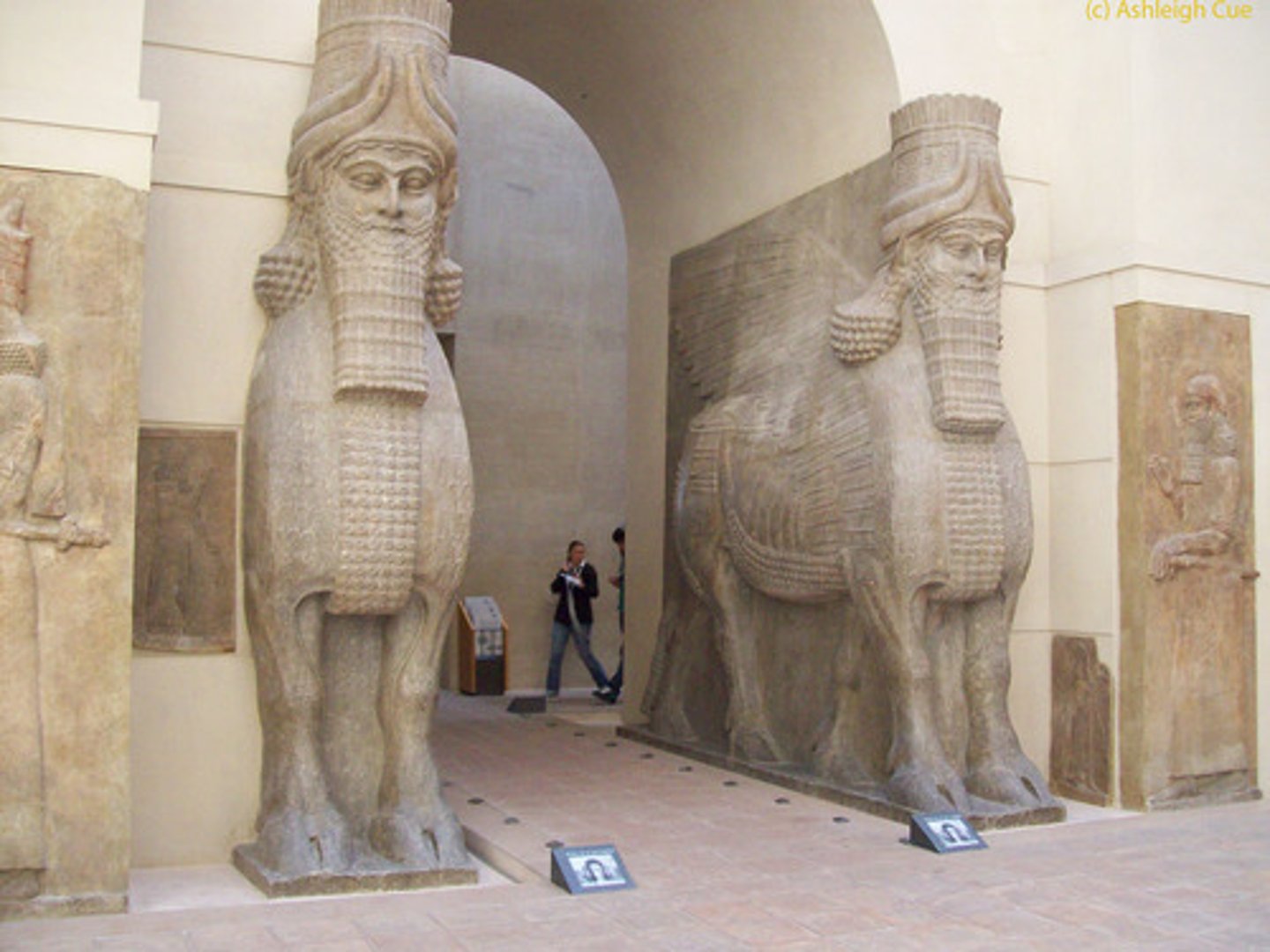
Assurbanipal and his queen in the garden
Ancient Near Eastern Period
Assyrian Culture
Ninevah (Iraq)
Fact: Most of Assurbanipals alabaster low relief panel displayed naratives of battle or of hunting, but some (like this) showed examples of palace life
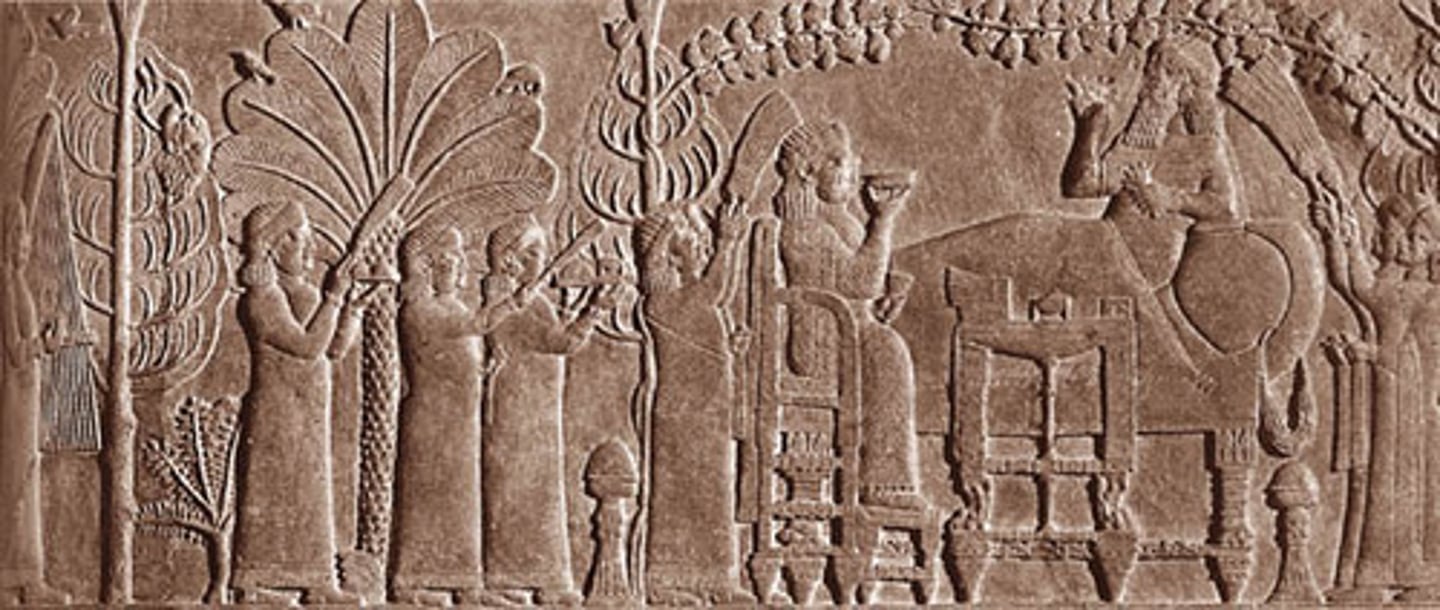
Ishtar Gate and Throne Room Wall
Ancient Near East Period
Neo-Babylonian culture
(Babylon) Iraq
Fact: Used Glazed Blue bricks for the Crenellated towers (notched walls for military defense). It was covered in dragons that were sacred to Marduk.

style
A particular manner, form, or character of representation, construction, or expression that is typical of a certain artist or a certain time or period
hierarchic scale
The use of differences in size to indicate relative importance . For example, with human figures, the larger the figure, the greater his or her importance.
Cuneiform
An early form of writing with wedge shaped marks impressed into wet clay. Primarily used by mesopotamians. Discovered by Sumer
City State
the largest and first mesopotamian city state was urik
Ziggurat
In ancient mesopotamia, a tall stepped tower of earthen materials, often supporting a shrine
Register
A device used in a system of spacial definition. In relief sculpture the placement of self-contained bands of relief in a vertical arrangement
Stele
A stone slab placed vertically and decorated with inscription or reliefs. Used as a grave marker or commemorative monument
Lamassu
Supernatural guardian-protector of ancient near eastern palaces and thrown rooms, often represented sculpturally as a combination of the bearded head of a man, powerful body of a lion or bull, wings of an eagle, and the horned headdress of a god, usually possessing five legs
Votive figures
An image created as a devotional offering to a deity
convention
A traditional way of representing forms
Palette of Narmer
Early Dynastic Period
Ancient Egyptian Culture
Hierakonpolis (Egypt)
Fact: Represents the unification of Egypt and the beginning of the countrys growth as a powerful nation state. Narmar, the ruler of upper egypt was in firm control of lower egypy.
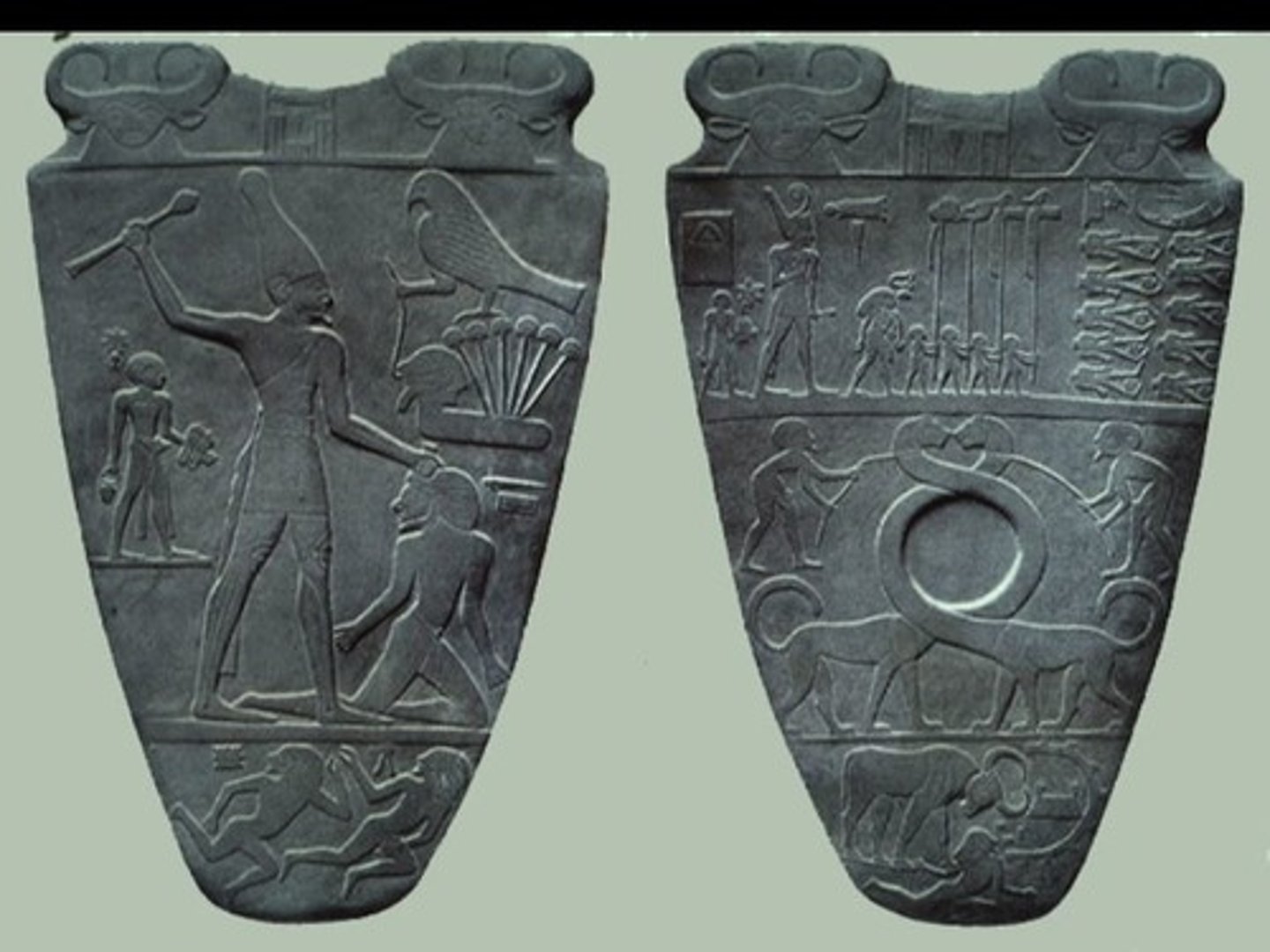
Djoser's Funerary Complex
Early Dynastic Period
Ancient Egyptian Culture
Saqqara (Egypt)
Fact: It symbolized a stairway to the sun god and a purpose, protecting the tomb. the funerary temple was used for continuing worship on the dead king.
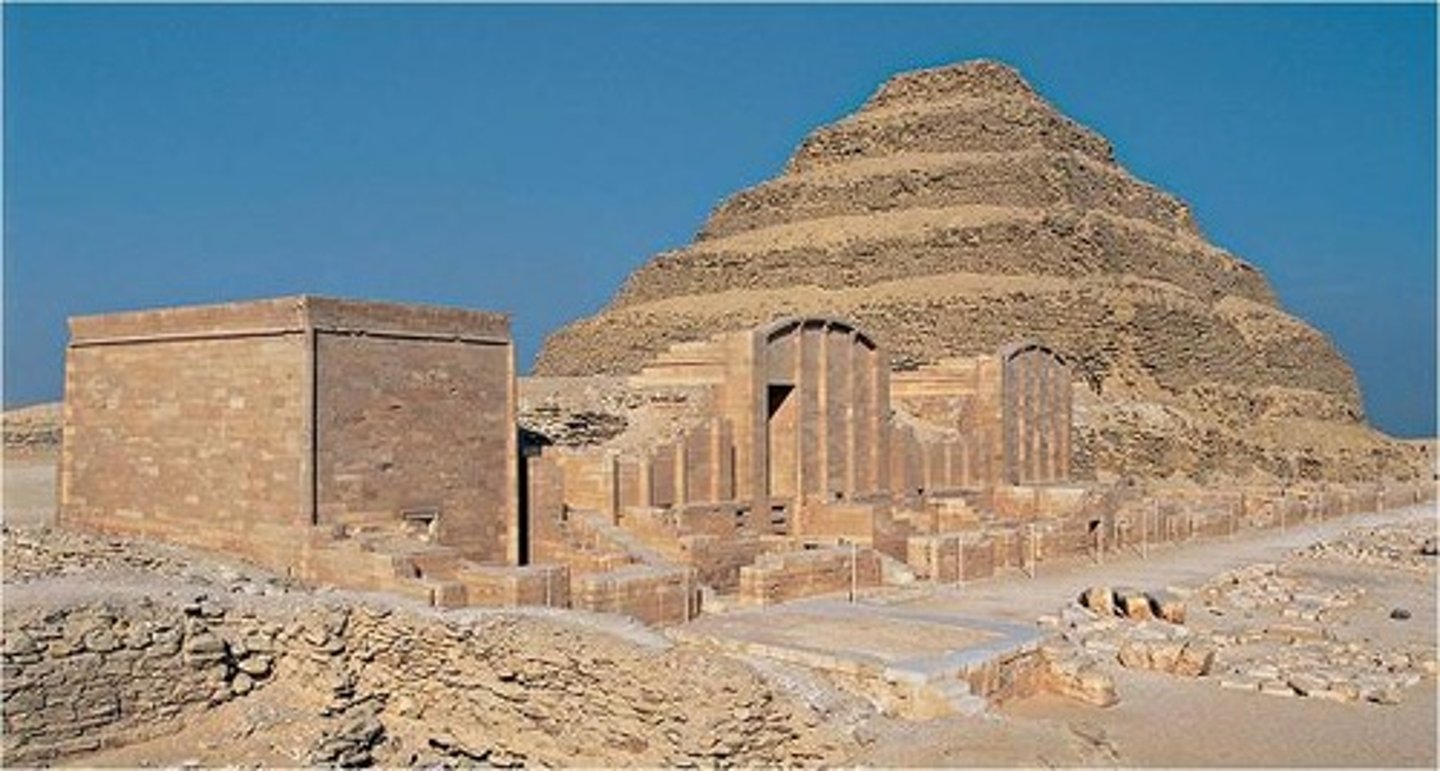
Great Pyramids of Giza
Old Kingdom Period
Ancient Egyptian Culture
Giza(Egypt)
Fact: Not the first but most famous. Built by three successive Fourth Dynasty Kings. Khufu (oldest and largest), Khafre(smaller), and Menkaure(smallest)
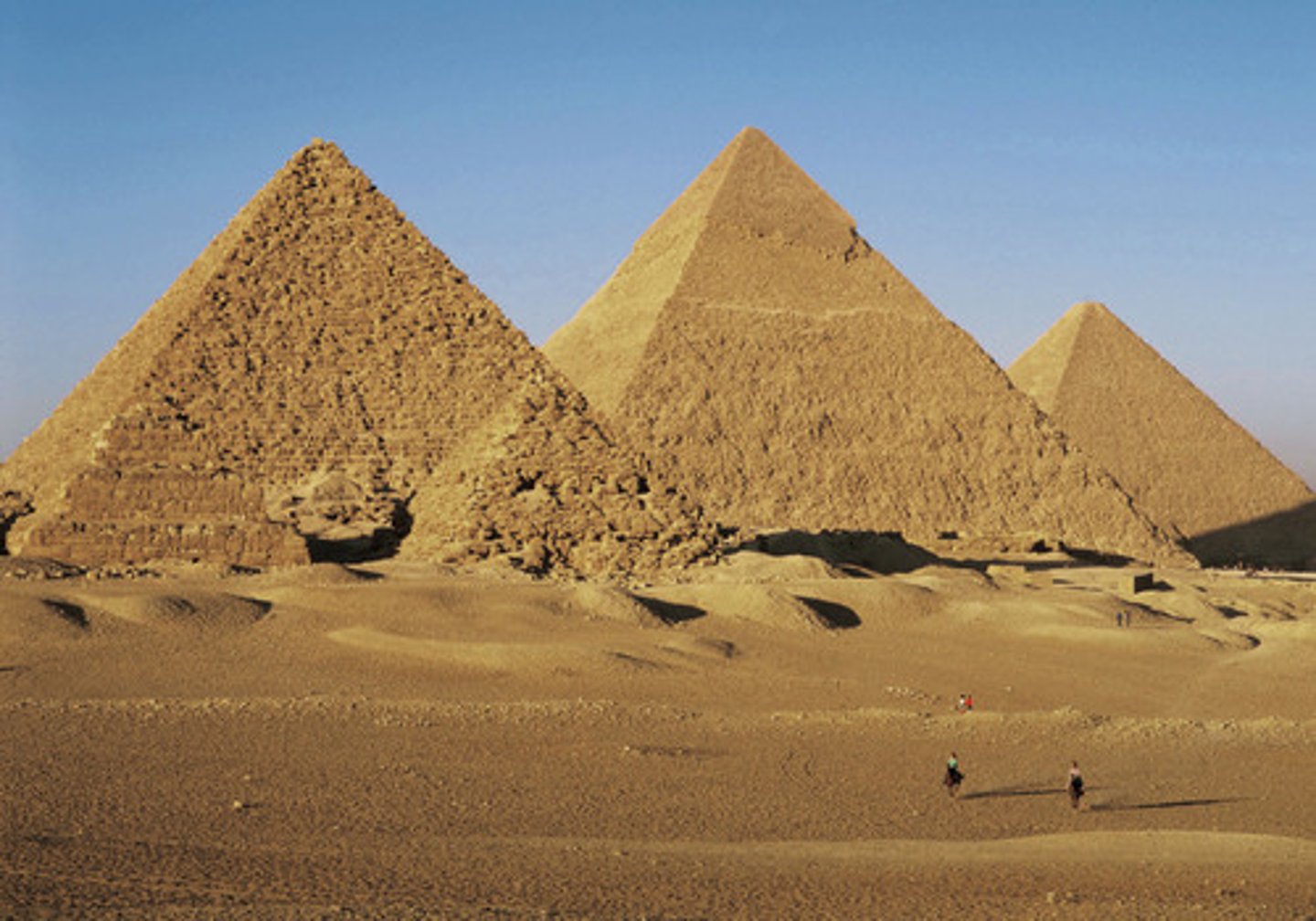
Portrait of Khafre
Old Kingdom Period
Ancient Egyptian Culture
Giza(Egypt)
Fact: Papyrus plants are beneath the king, symbolizing his power over both upper and lower Egypt. Horus, the falcon god sits behind the king, protecting him with his wings. He wears a royal costume and there is a sense of permanence. the type of stone radiates blue with light.
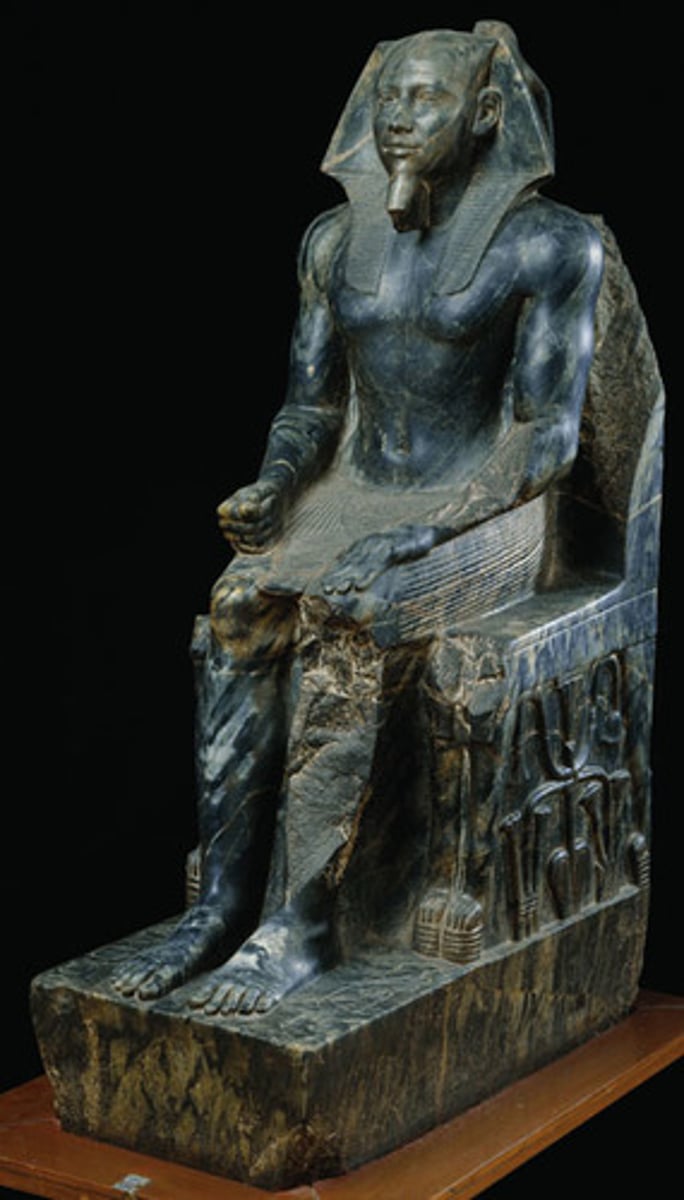
Seated Scribe
Old Kingdom Period
Ancient Egyptian Culture
Saqqara (Egypt)
Fact: Old Kingdom sculptors also made statues of less prominent people. A more lively and less formal mode is employed here. He is slightly chubby, signifying a life free from hard physical labor.

Funerary Temple of Hatshepsut
New Kingdom Period
Ancient Egyptian Culture
Deir el-Bahri (Egypt)
Fact: Hatshepsut was one of the few Female Kings. In art she was represented as a male (occasionally wearing a false beard). Designed for funeral rites and commemorative ceremonies and unlike other tombs is much larger than the tomb itself.
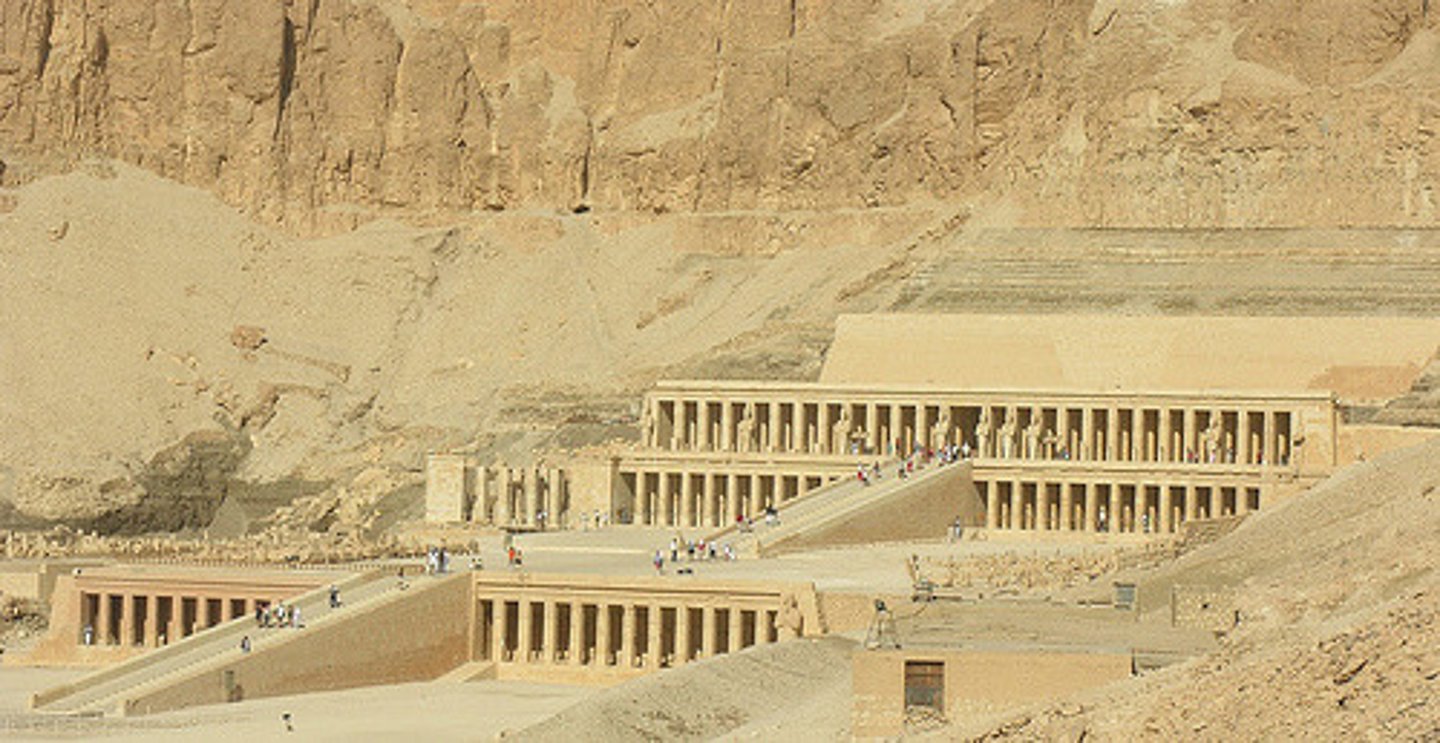
Colossal Figure of Akhenaten
New Kingdom/Amarna Period
Ancient Egyptian Culture
Karnak (Egypt)
Fact: During this time and in this figure portraits of the king where very stylized and sometime distorted. (Amara style)
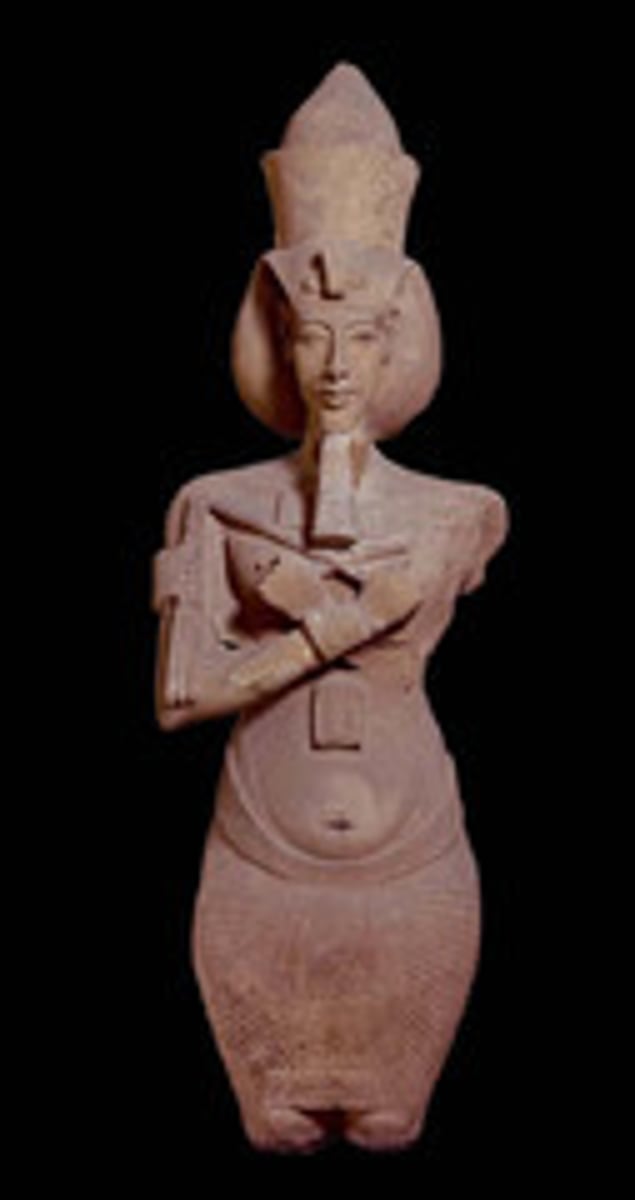
Akhenaten and Family
New Kingdom/Amarna Period
Ancient Egyptian Culture
(Tell el-aAmara) Egypt
Fact: Shows Akhenaten and Queen Nefertiti in a relief style sculpture. This shows the loving involvement of parents in their childrens life that was never shown before.
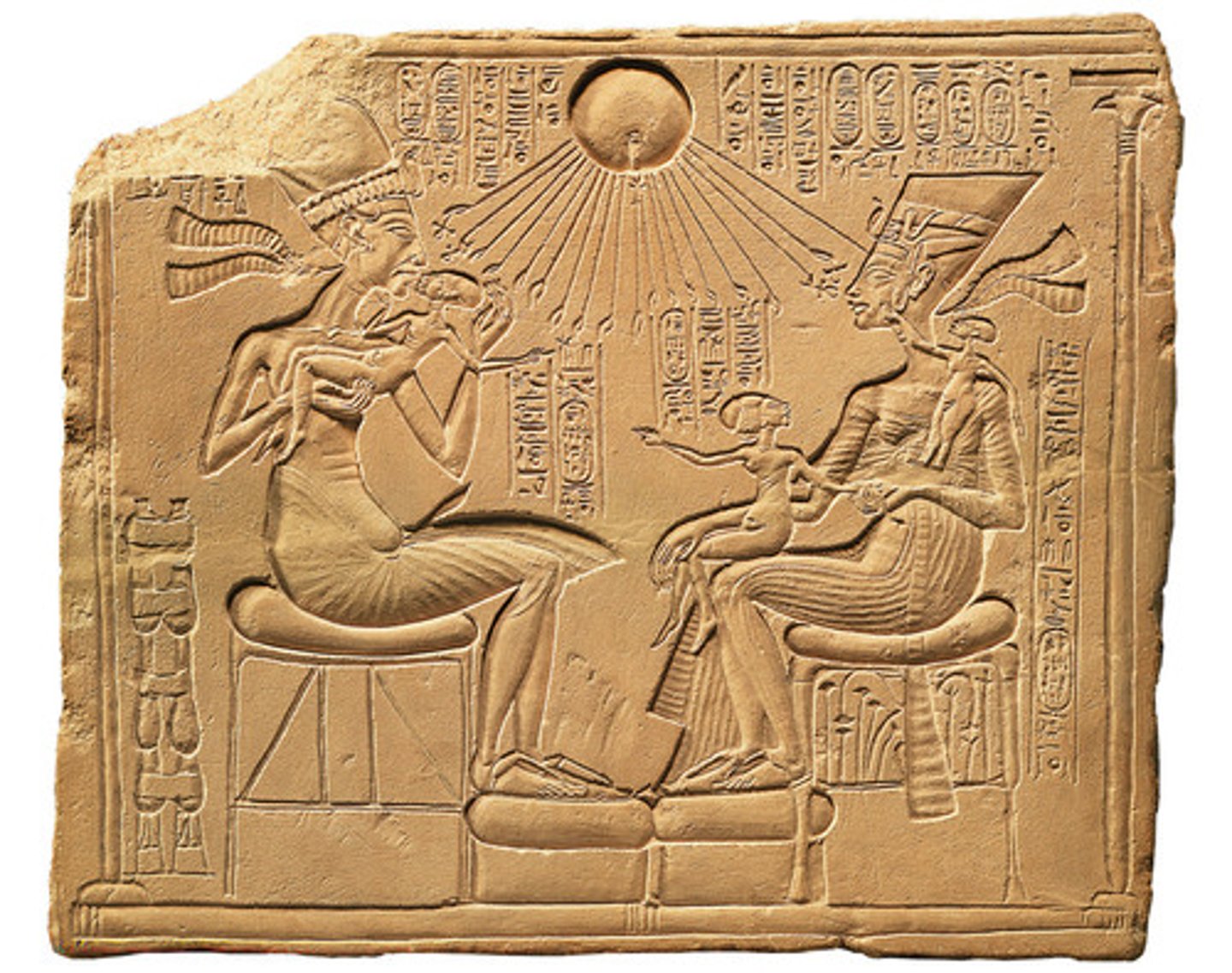
Hieroglyphics
Picture writing, words and ideas rendered in the form of pictoral symbols
Conventions
A traditional way of representing forms
Palete
A hand held support used by artist for arranging colors and mixing paint during the process of painting. In ancient egypt, it was a flat stone used to grind and prepare make up
Mastaba
A flat-topped, one story Egyptian structure with slanted walls built over an ancient Egyptian Underground Tomb
Serdab
In ancient Egyptian Tombs, the small room in which the KA statue was placed
Necropolis
A large cemetery or burial area: Literally the "city of the dead"
ka
statue of the deceased
Portico
In architecture, a projecting roof or porch supported by columns, often making an entrance.
Hypostyle hall
A large interior room characterized by many closely spread colums that support its roof
Bull Leaping
Late Minoan Period
Ancient Aegean Culture
Knosses, Crete
Fact: One of many pieces of minoan art found in the east wing of the Knosses Complex. It is in the "Flying Gallop" pose. Could be an example of a fertility ritual.
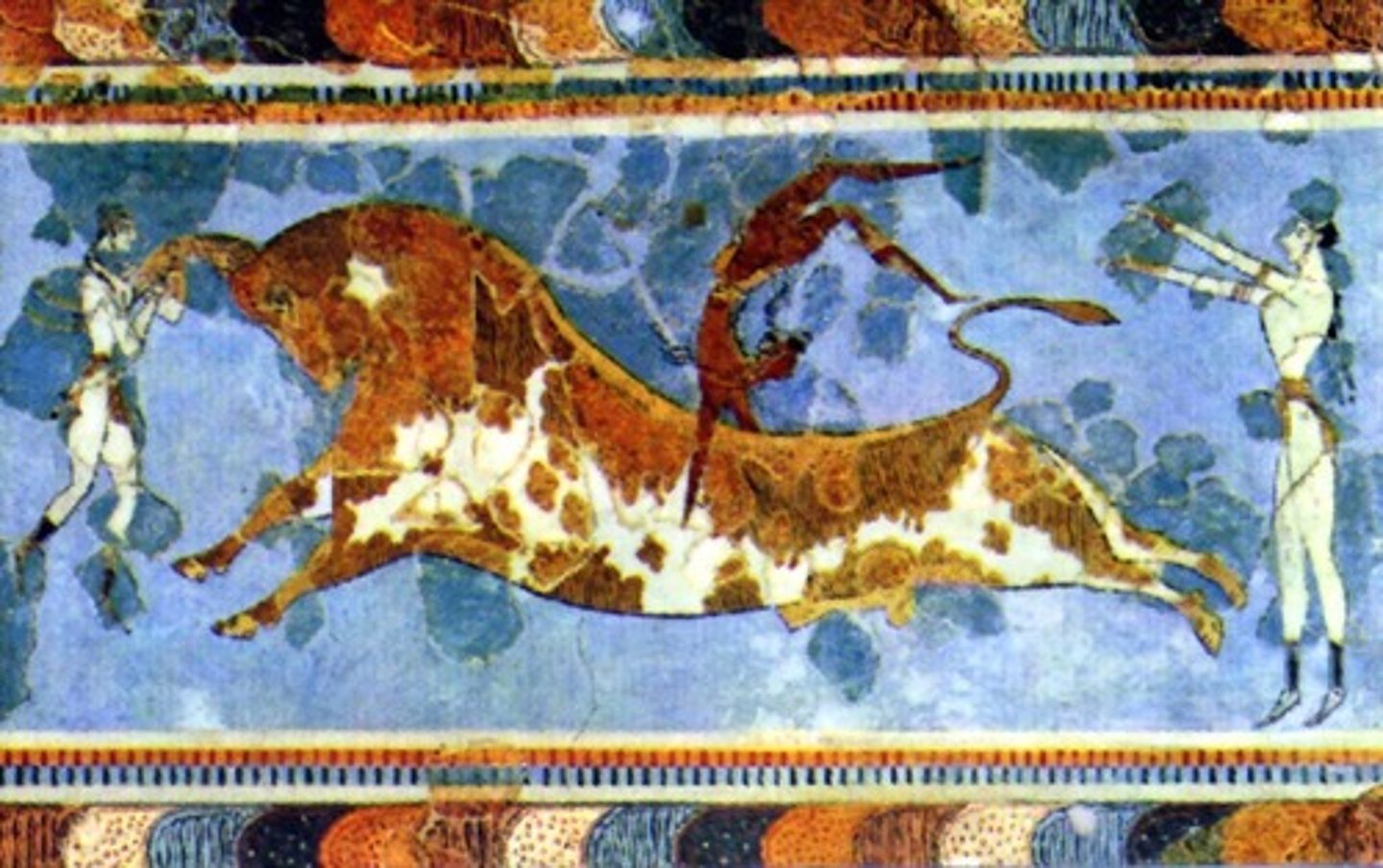
Dipylon Funerary Krater
Geometric Period
Pre/emerging Greek Culture
(Dipylon Cemetery) Athens
Fact: Period full of ceramic vessels covered in spirals, diamonds, and cross hatching. LArge Funerary vessell that seves as a grave marker(mixed wine and water in it). shows funerary rituals associated with an important person dying.
Top register: body of deceased possibly ataiting the new practice of cremation. Two figures stand next to him in grief
Middle register: soldiers move in solum procession
No sense of depth and geometric shapes used to represent people but shows human loss
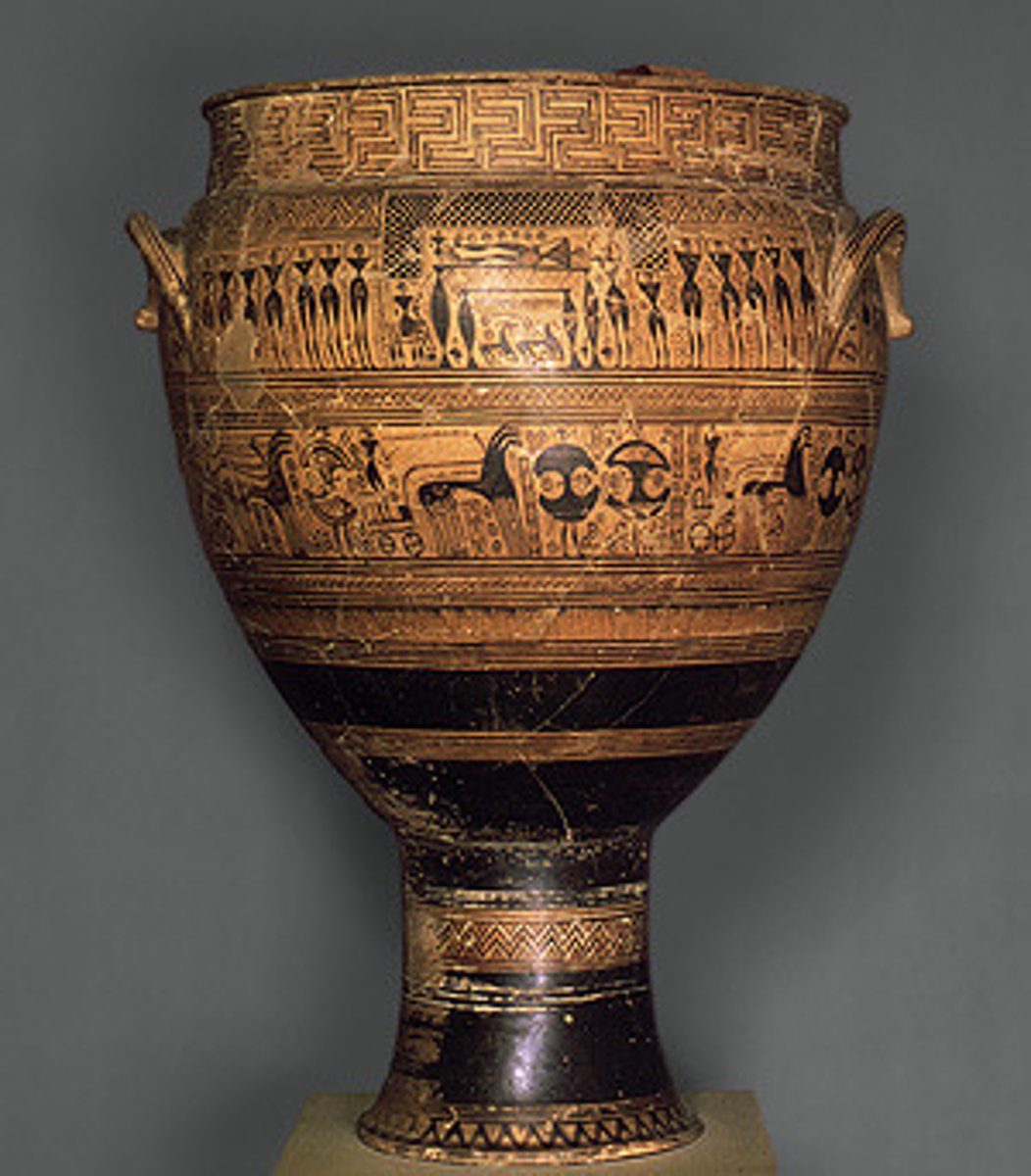
Exerkias, Ajax and Achilles playing a game
Archaic Period
Ancient Greek culture
Athens
Fact: Done in black figure. They are playing dice. Achilles died in battle and Ajax was so hurt that he killed himself. Here, Achilles is displayed as slightly bigger and is winning showing his prominence
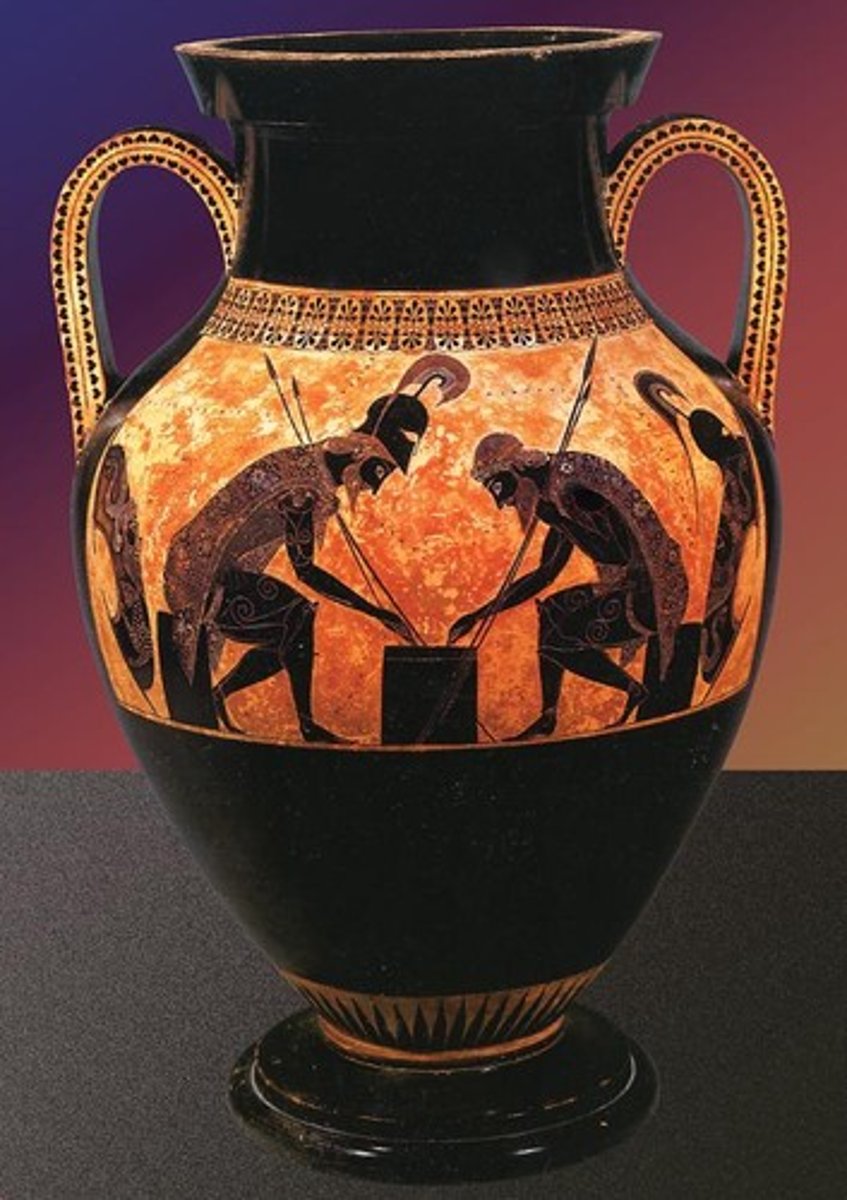
Temple of Aphaia
Archaic Period
Ancient Greek culture
Aegina
Fact:Doric Temple, dedicated to local goddess named Aphaia. Set in relation to an outside alter. Ouside revealed a sculptural mass which invited the viewer to look around the whole exterior.
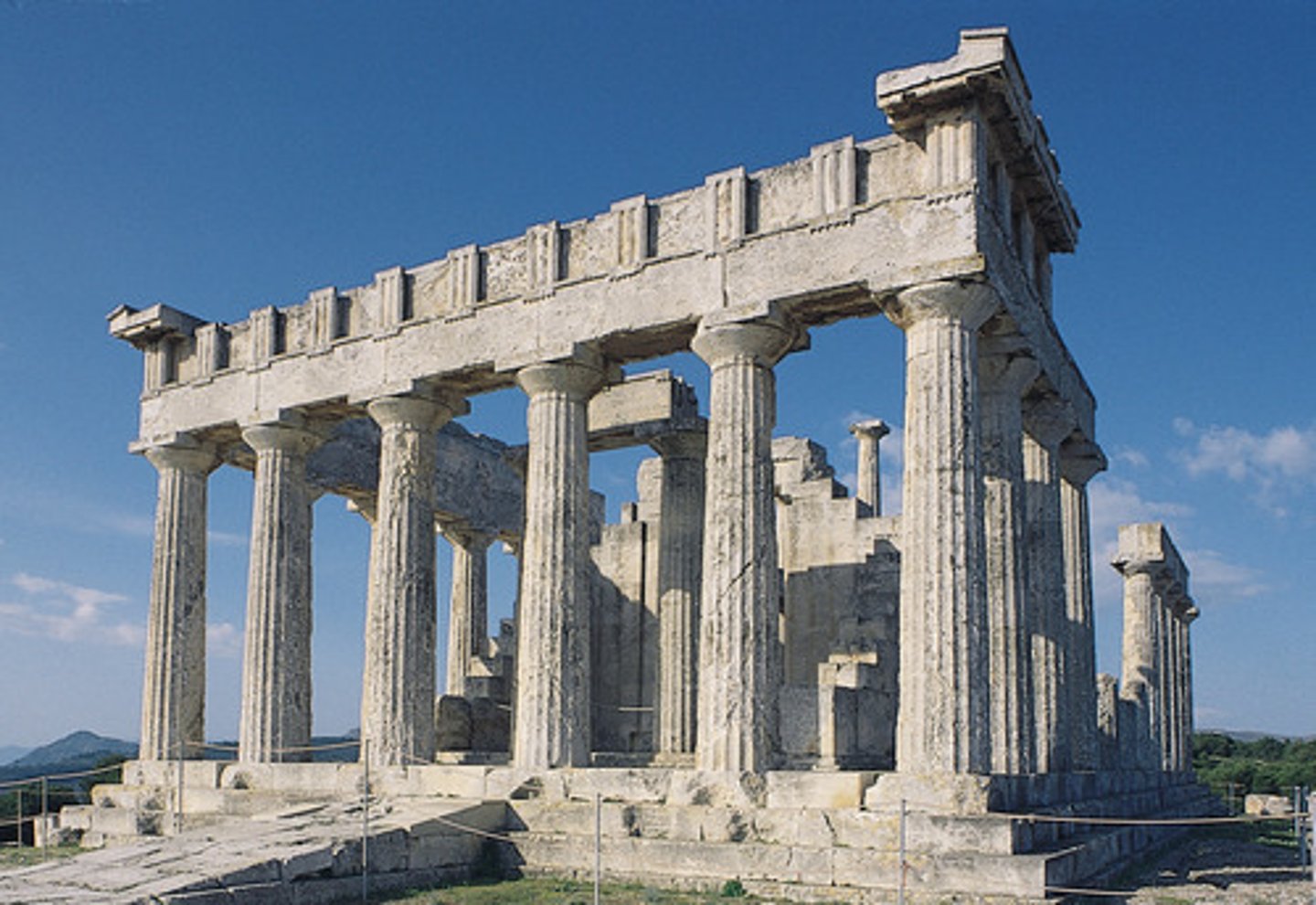
Riace Warrior
Early Classical period
Ancient Greek Culture
Riace (Italy)
Fact: striking balance between the idealized smoothness of perfected anatomy and reproduction of details observed from nature. Eyeballs are made of bone and glass
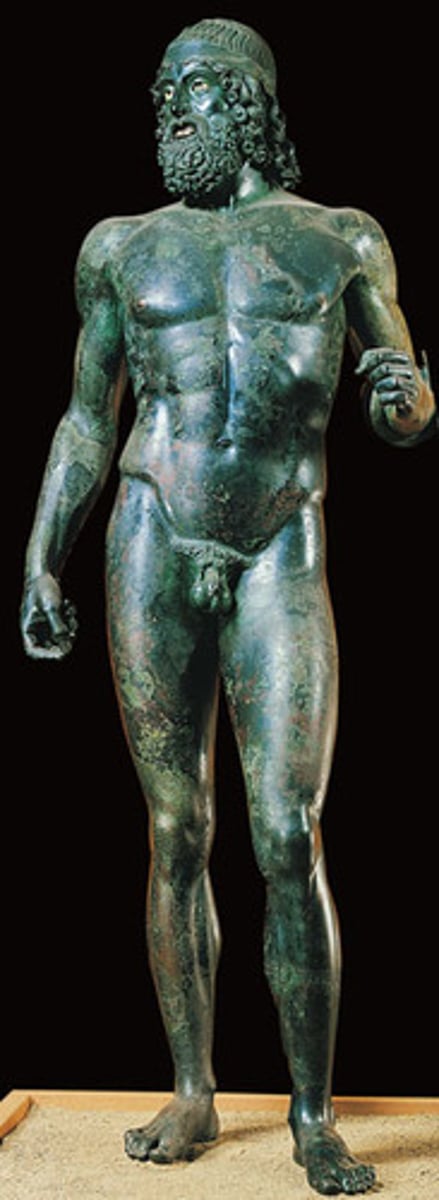
Kallikrates & Iktinos
The Parthenon
High Classical Period
Ancient Greek Culture
Athens
Fact: huge mathematical feat. the ratio 4:9 was important as it was what gave diameter to the comums and space between them.the columns are tilted inward so they appear strait from a distance. The building has a buyont feeling because of this instead of feeling heavy. The art shows the triumph of the democratic city states of Greece over persia, preeinance of athens, and triumph of enlightened greek civilization over barbariasm.
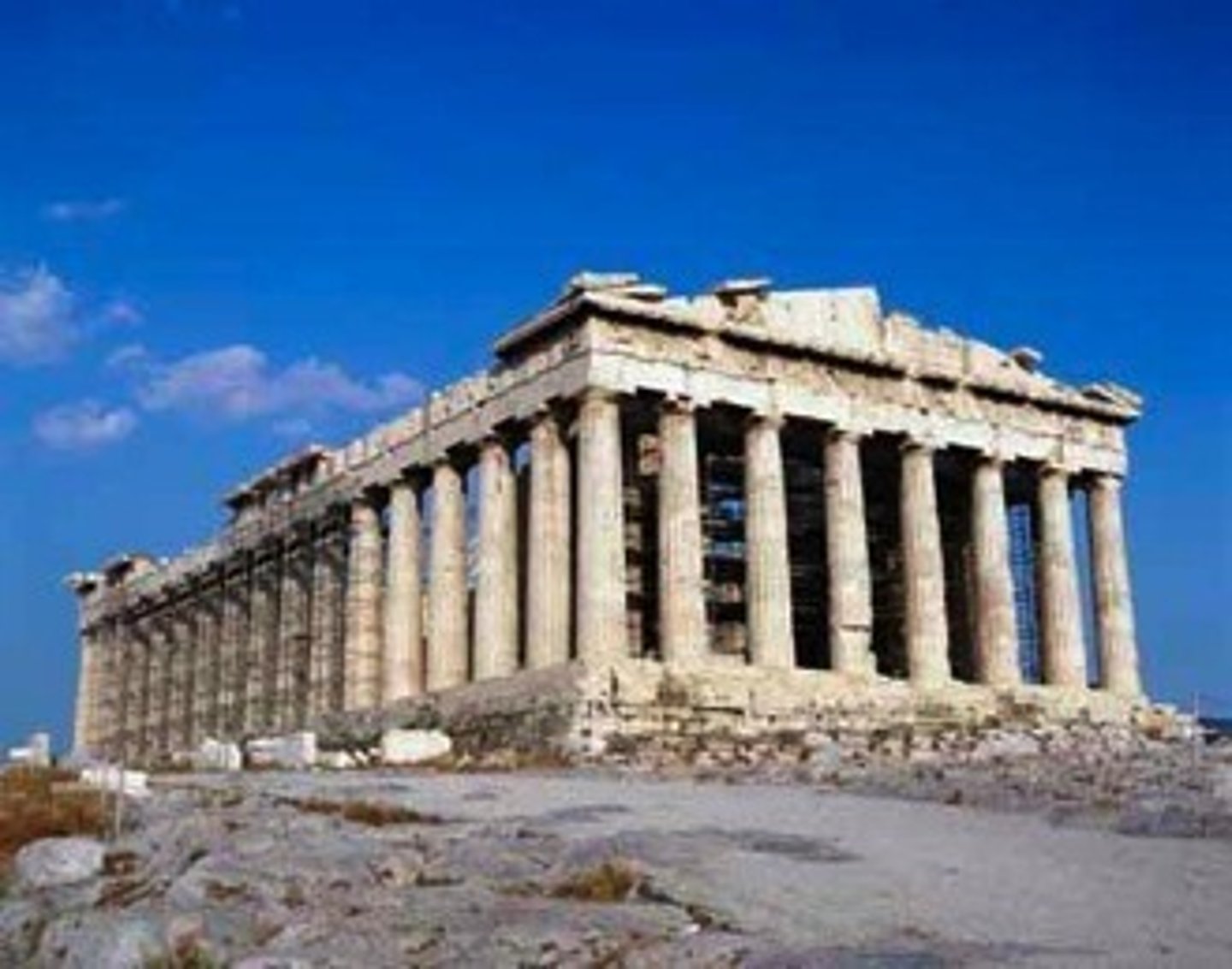
Praxiteles
Aphrodite of Knidos
Late Classical Period
Ancient Greek Culture
Knidos
Fact: Statue of Aphrodite where she was completly naked. This was the first of its time and set a new standard.
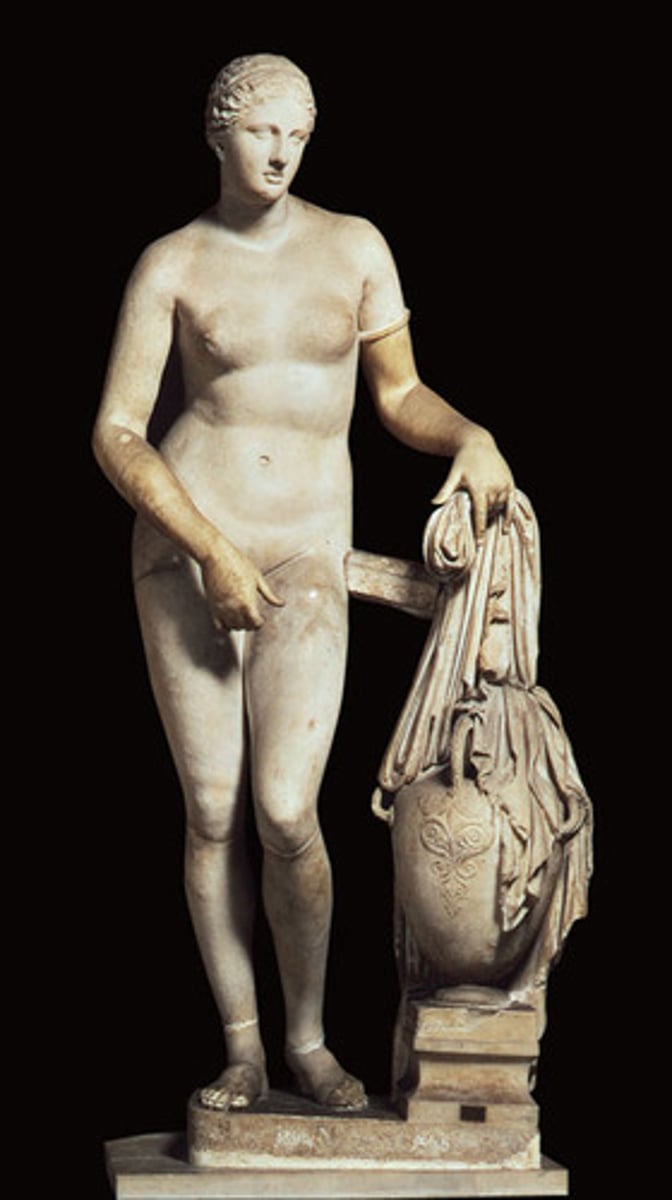
Philoxenus of Eretria OR helen of Egypt
Alexander the Great confronts Darius III
Late classical Period
Ancient Greek Culture
Knidos
Fact: Documents a growing taste for dramatic narative. Alexander challenges a persian leader who stretches his hand out signalling his defeat. Illusion of solid figures.
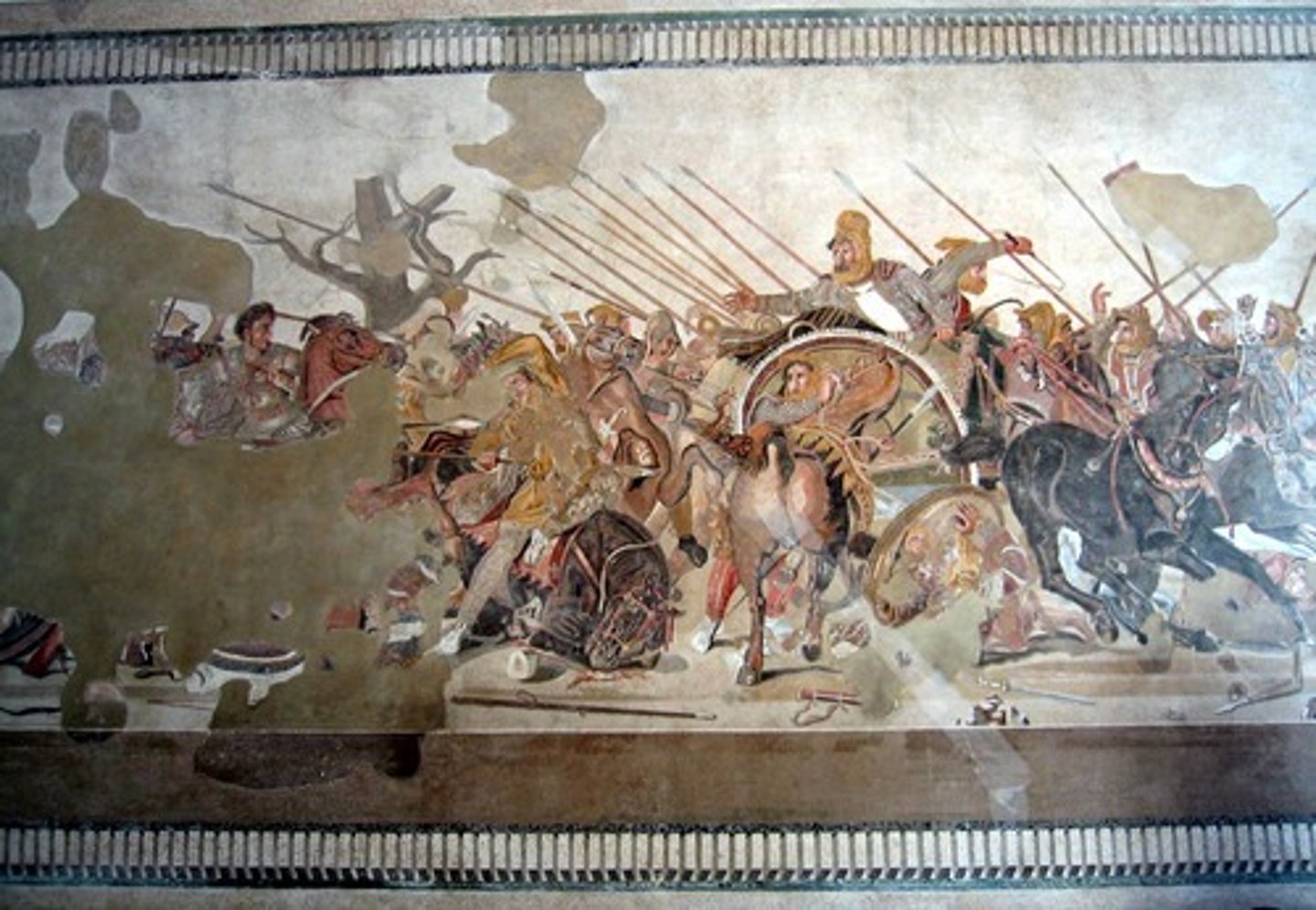
Epigonas
Dying Gallic Trumpeter
Hellenistic Period
Ancient Greek Culture
Pegamon
Fact: This was a Celtic Soldier Trumpetor who has fallen. He is neck ring or "tork" signalling that he is a barbarian.Downcast gaze shows he is at the point of death.
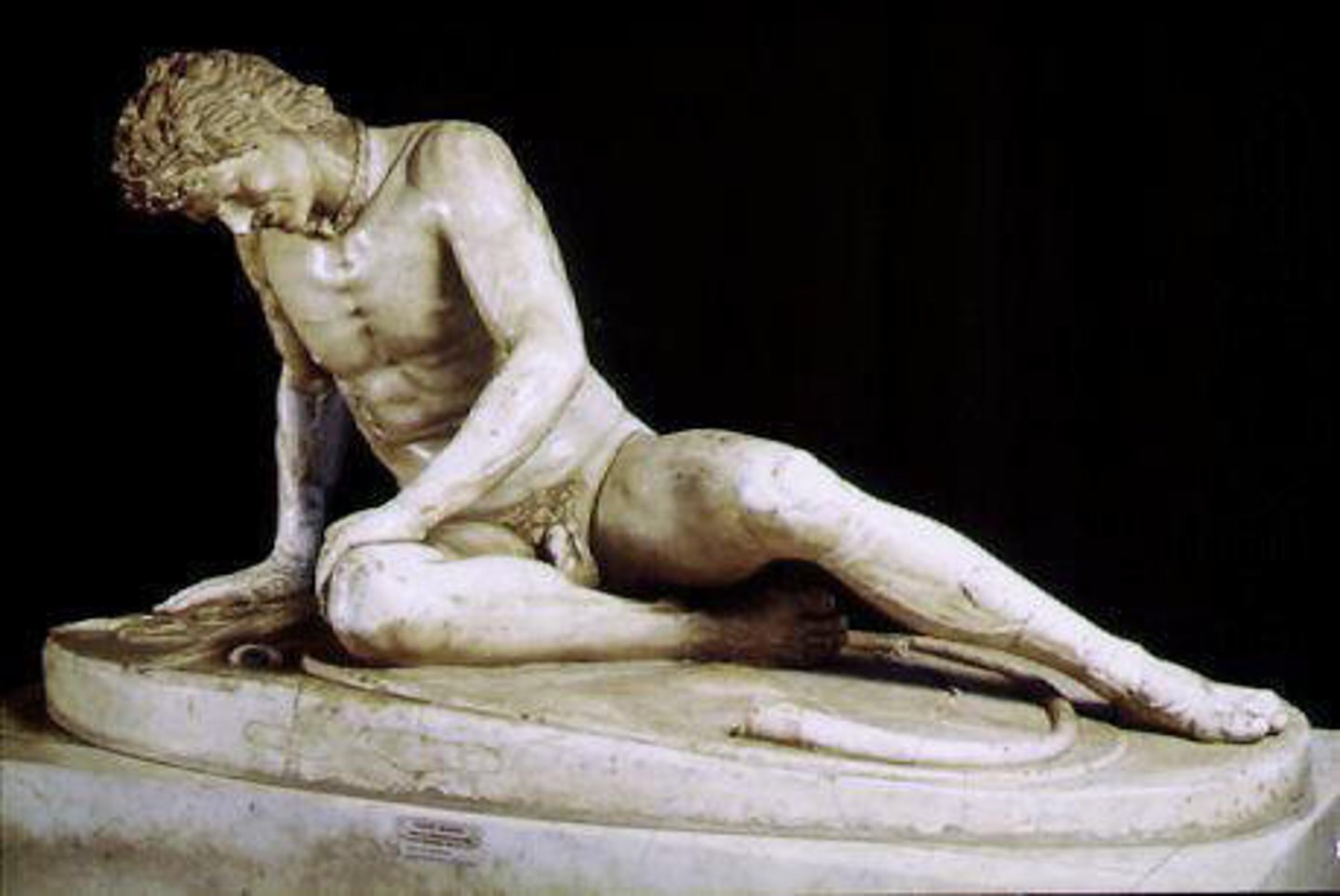
Rython
A vessel in the shape of a figure or an animal, ued for drinking or pouring liquids on special occasions
Krater
An ancient Greek Vessel for mixing wine and water, with many substitutes they all have a distinct shape
Black Figure
A technique of ancient greek ceramic decoration in which black figures are painted on red clay body
Red Figure
A technique of Ancient Greek ceramic decoration charachterized by red clay colored figures on a black background.
Sanctuary
A sacred or holy enclosure used for worship. In ancient greece and rome it consisted of one or more temples and an altar
Peristyle
In greek architecture, a surrounding colonnade. A peristyle building is surrounded on the exterior by a collonade. The courtyard is open and has a pool and garden
Cella
The principle interior room at the center of a Greek or roman temple within which the cult statue was usually housed
Elevations
The arrangement, proportions, and details of any vertical side or face of the building.
Stoa
In Greek architecture, a long roofed walkway, usually having columns on one long side and a wall on the other
Caryatids
a sculpture of a draped female figure acting as a column supporting a entablature
Capital
The sculpted block that tops a column and contains different decorative elements
Orders
Doric, Ionic, Corinthian
Freize
The middle element of a architrave. Usually decorated with sculpture, painting, or molding.
Pediment
A triangular Gable found found over major architectural elements
Triglyph
Rectangular blocks on a Doric Colum Identified by 3 carved grooves.
Kouros/Kore
An Archaic statue of a greek woman
Contrapposto
Italian term meaning "set against" used to describe the classical convention of representing human figures with opposing alterations of tension and relaxation on either side of the central axis to imbue issues with a sense of potential for movement
Mosaic
Image formed by arranging small stone collored glass pieces (tessarae) and affixing them to a hard stable surface